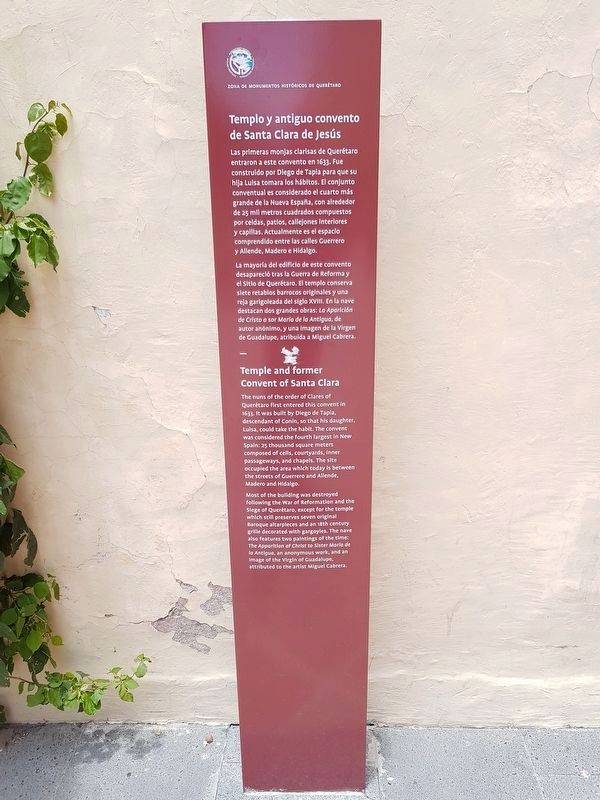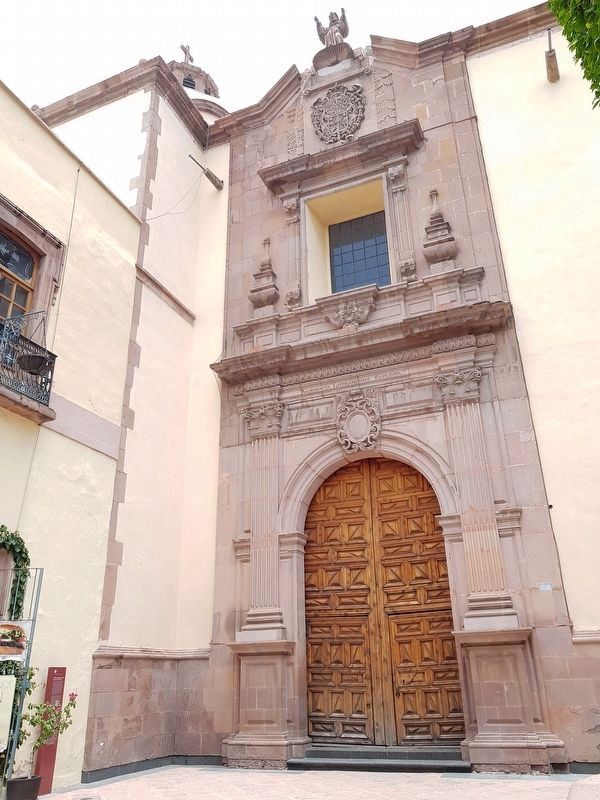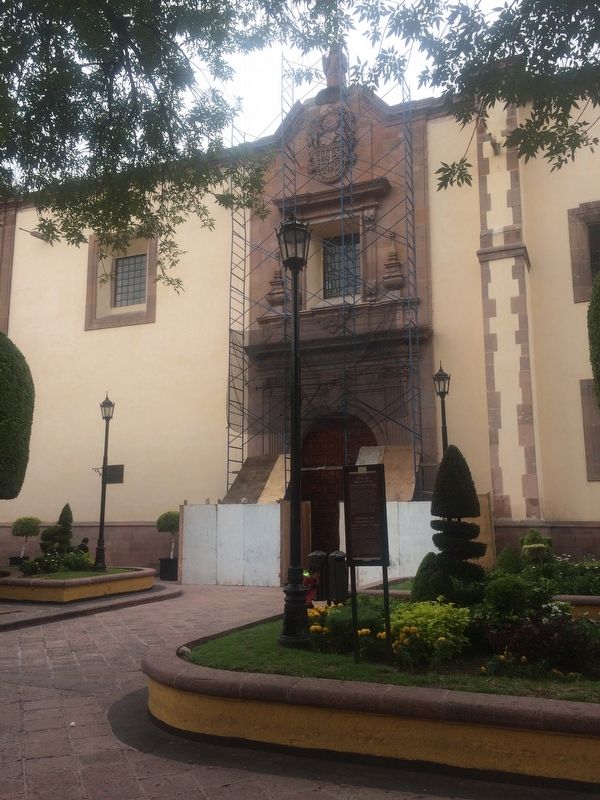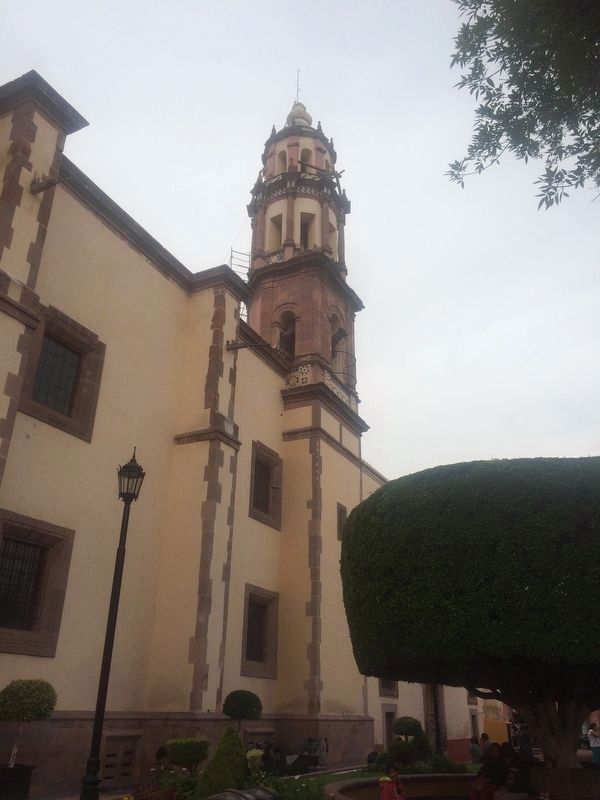Santiago de Querétaro in Querétaro, Mexico — The Central Highlands (North America)
Temple and former Convent of Santa Clara
Inscription.
Templo y antiguo convento de Santa Clara de Jesús
Las primeras monjas clarisas de Querétaro entraron a este convento en 1633. Fue construido por Diego de Tapia para que su hija Luisa tomara los hábitos. El conjunto conventual es considerado el cuarto más grande de la Nueva España, con alrededor de 25 mil metros cuadrados compuestos por celdas, patios, callejones interiores y capillas. Actualmente es el espacio comprendido entre las calles Guerrero y Allende, Madero e Hidalgo.
La mayoría del edificio de este convento desapareció tras la Guerra de Reforma y el Sitio de Querétaro. El templo conserva siete retablos barrocos originales y una reja garigoleada del siglo XVIII. En la nave destacan dos grandes obras: La Aparición de Cristo a sor María de la Antigua, de autor anónimo, y una imagen de la Virgen de Guadalupe, atribuida a Miguel Cabrera.
Temple and former Convent of Santa Clara
The nuns of the order of Clares of Querétaro first entered this convent in 1633. It was built by Diego de Tapia, descendant of Conín, so that his daughter, Luisa, could take the habit. The convent was considered the fourth largest in New Spain: 25 thousand square meters composed of cells, courtyards, inner passageways, and chapels. The site occupied the area which today is between the streets of Guerrero and Allende, Madero and Hidalgo.
Most of the building was destroyed following the War of Reformation and the Siege of Querétaro, except for the temple which still preserves seven original Baroque altarpieces and an 18th century grille decorated with gargoyles. The nave also features two paintings of the time: The Apparition of Christ to Sister María de la Antigua, an anonymous work, and an image of the Virgin of Guadalupe, attributed to the artist Miguel Cabrera.
Erected 2018 by Municipalidad de Querétaro.
Topics. This historical marker is listed in these topic lists: Charity & Public Work • Churches & Religion • Colonial Era • Man-Made Features. A significant historical date for this entry is July 21, 1633.
Location. 20° 35.52′ N, 100° 23.671′ W. Marker is in Santiago de Querétaro, Querétaro. Marker is on Calle Francisco I. Madero just east of Calle Vicente Guerrero, on the left when traveling east. Touch for map. Marker is in this post office area: Santiago de Querétaro QUE 76000, Mexico. Touch for directions.
Other nearby markers. At least 8 other markers are within walking distance of this marker. Temple of the Ex-Convent of Santa Clara de Jesus (a few steps from this marker); Vicente Guerrero Garden
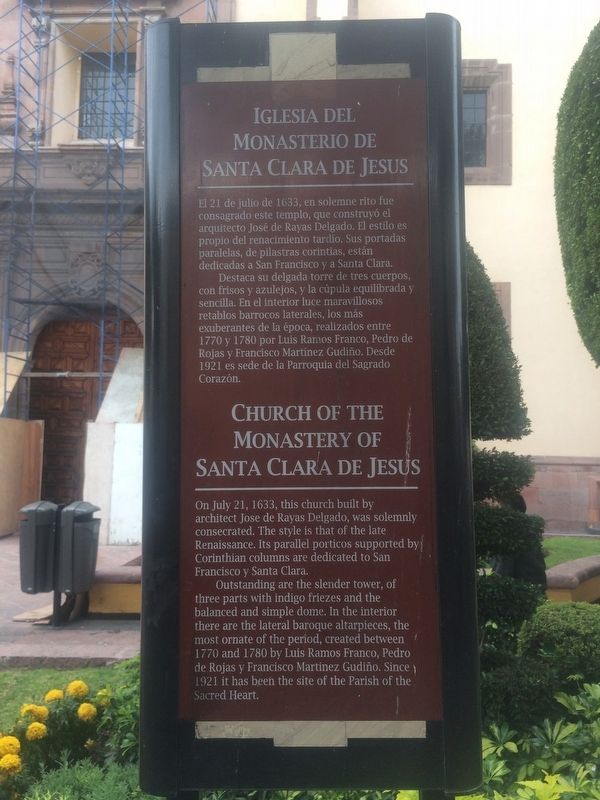
Photographed By J. Makali Bruton, November 13, 2016
2. Church of the Monastery of Santa Clara de Jesus Marker
This previous marker was replaced in 2018. It read:
Iglesia del Monasterio de Santa Clara de Jesus El 21 de julio de 1633, en solemne rito fue consagrado este templo, que construyó el arquitecto José de Rayas Delgado. El estilo es propio del renacimiento tardío. Sus portadas paralelas, de pilastras corintias, están dedicadas a San Francisco y a Santa Clara.
Destaca su delgada torre de tres cuerpos, con frisos y azulejos, y la cúpula equilibrada y sencilla. En el interior luce maravillosos retablos barrocos laterales, los más exuberantes de la época, realizados entre 1770 y 1780 por Luis Ramos Franco, Pedro de Rojas y Francisco Martínez Gudiño. Desde 1921 es sede de la Parroquia del Sagrado Corazón.
English:
Church of the Monastery of Santa Clara de Jesus On July 21, 1633, this church built by architect Jose de Rayas Delgado, was solemnly consecrated. The style is that of the late Renaissance. Its parallel porticos supported by Corinthian columns are dedicated to San Francisco y Santa Clara.
Outstanding are the slender tower, of three parts with indigo friezes and the balanced and simple dome. In the interior there are the lateral baroque altarpieces, the most ornate of the period, created between 1770 and 1780 by Luis Ramos Franco, Pedro de Rojas y Francisco Martinez Gudiño. Since 1921 it has been the site of the Parish of the Sacred Heart.
Destaca su delgada torre de tres cuerpos, con frisos y azulejos, y la cúpula equilibrada y sencilla. En el interior luce maravillosos retablos barrocos laterales, los más exuberantes de la época, realizados entre 1770 y 1780 por Luis Ramos Franco, Pedro de Rojas y Francisco Martínez Gudiño. Desde 1921 es sede de la Parroquia del Sagrado Corazón.
Outstanding are the slender tower, of three parts with indigo friezes and the balanced and simple dome. In the interior there are the lateral baroque altarpieces, the most ornate of the period, created between 1770 and 1780 by Luis Ramos Franco, Pedro de Rojas y Francisco Martinez Gudiño. Since 1921 it has been the site of the Parish of the Sacred Heart.
Credits. This page was last revised on August 21, 2018. It was originally submitted on December 7, 2016, by J. Makali Bruton of Accra, Ghana. This page has been viewed 232 times since then and 24 times this year. Photos: 1. submitted on August 14, 2018, by J. Makali Bruton of Accra, Ghana. 2. submitted on December 7, 2016, by J. Makali Bruton of Accra, Ghana. 3. submitted on August 14, 2018, by J. Makali Bruton of Accra, Ghana. 4, 5. submitted on December 7, 2016, by J. Makali Bruton of Accra, Ghana.
